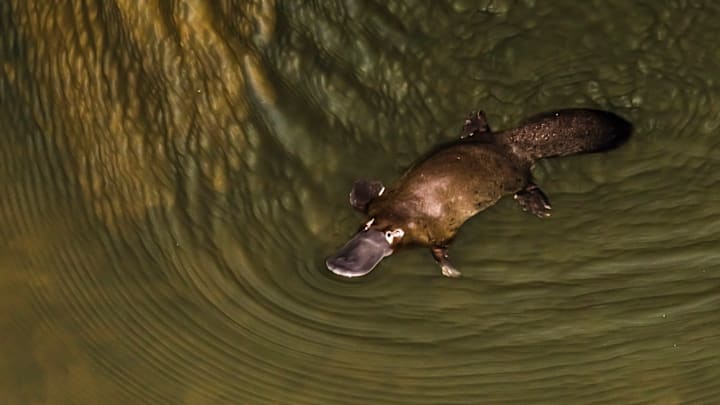The platypus is arguably one of the most distinct animals on the planet. Here are a few things you might not have known about this quirky creature.
1. Platypuses don’t have stomachs.
Platypuses (platypodes and platypi are technically also correct, but much rarer in use) aren’t the only animals to forgo an acid-producing part of the gut; spiny echidnas, and nearly a quarter of living fishes all have a gullet that connects directly to their intestines.
2. Platypus bills give them a “sixth sense.”

A platypus’s bill has thousands of cells that give it a sort of sixth sense, allowing them to detect the electric fields generated by all living things. It’s so sensitive that the platypus can hunt with its eyes, ears, and nose all closed, relying entirely on the bill’s electrolocation.
3. Platypuses used to be giant.
The ancient versions of a lot of modern animals, including penguins, were oversized monsters compared to the animals we know today. Platypuses are no different: In 2013, the discovery of a single tooth helped researchers identify a prehistoric platypus that was more than three feet long—double the size of the modern animal.
4. The platypus is a monotreme—which means “single hole” in Greek.
Platypuses are one of only five species of extant monotremes—just them and four species of echidna—which split from the rest of the mammals 166 million years ago. These egg-laying mammals get their name from the hole that serves as both an anus and a urino-genital opening. In 2008, scientists deciphered the entire DNA of the duck-billed platypus and determined that, in accordance with the animal’s somewhat bizarre appearance, the platypus shared genes with reptiles, birds, and mammals.
5. Platypuses nurse without nipples.
Although platypuses are born out of leathery eggs, the babies nurse from their mother. Female platypuses, however, don’t have nipples. Instead, their milk is released out of mammary gland ducts on their abdomen. The babies drink it up by sucking it out the folds of their mother's skin, or her fur.
6. Male platypuses have venomous spurs.

Platypuses are one of just a few venomous mammals, which is one of their more reptilian characteristics. But unlike snakes, a platypus’s venom isn’t in his teeth. Instead, males have a hollow spur on each hind leg from which venom is dispensed—but only sometimes. Although the spur itself is always there, the venom gland to which it is connected is seasonally-activated and only produces venom during mating season, indicating that its use is for fending off competing males.
7. Platypuses have retractable webbing.

Although they can only stay submerged in water for a few minutes—they are mammals, after all—platypuses are much better suited to scooting around in water than they are on land. Much like an otter, they prune their thick coat to add air bubbles that act as insulation in the cool rivers where they hunt. Out on land, the platypus’s short limbs mean it has to exert 30 percent more energy than a similarly sized land-based mammal just to move around. All that said, they do have one particular adaptation to ease their terrestrial travel: The webbing between their front claws—a boon when paddling through streams—retracts when the platypus ambles up the riverbank to expose sharp claws.
8. Scientists thought the first known platypus was a hoax.

When the first platypus specimen was sent back to England from Australia in the late 18th century, the scientists who examined it thought that someone was playing a trick on them. “It naturally excites the idea of some deceptive preparation by artificial means,” zoologist George Shaw wrote in the first scientific description of the platypus, published in 1799. One of the most remarkable and weird aspects of the platypus—its ability to lay eggs—wasn’t discovered for another 100 years.
9. Platypuses use gravel as makeshift teeth.
Platypuses don’t have teeth inside their bill, which makes it difficult to chew some of their favorite foods—but they have worked out a pretty ingenious solution. Along with worms, insects, shellfish, and whatever else these bottom-feeders scoop up to make a meal out of, the platypus also picks up gravel from the riverbed. The platypus packs it all into pouches in his cheek to carry it up to the surface where it munches away, using the bits of gravel as makeshift teeth to break up tougher food.
10. Platypuses use their tails for all sorts of things.
Unlike beavers, which have very visually similar tails, platypuses don’t use their tails to slap the water in warning, or even to move them through the water. Most of the time, the primary function of the platypus’s tail is just to store up to nearly half of the animal's body fat in case of a food shortage. A female platypus also uses her tail to hold incubating eggs against her warm body.
11. The platypus is considered “near-threatened.”
In 2014, the International Union for the Conservation of Nature (IUCN) deemed the platypus “near-threatened.” The animals live in freshwater wetlands along Australia’s east coast (including Victoria, Tasmania, South Australia, Queensland, and New South Wales). The fact that, according to the IUCN, “[t]here has been no robust assessment of the population size of the Platypus either nationwide or for the key states in the species’ geographic range” makes the species’ true numbers hard to determine. There may be an adult population of 300,000, but that number is on the decline. Habitat destruction and pollution of waterways are major threats.
12. They’re protected by Australian law.
If you’re lucky enough to see a platypus in the wild, leave it where it is. The animals are protected by law and “cannot be captured or killed, except for scientific research,” according to the Australian Museum. Doing so carries major penalties: One man who recently nabbed a wild platypus from a waterway in Queensland faces up to $289,000 in fines.
A version of this story originally ran in 2018; it has been updated for 2023.
